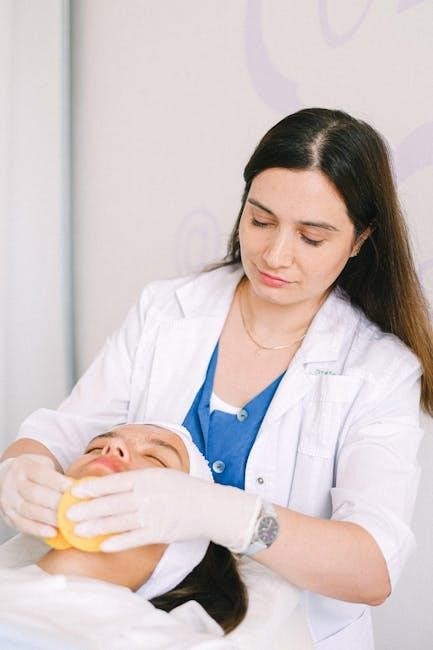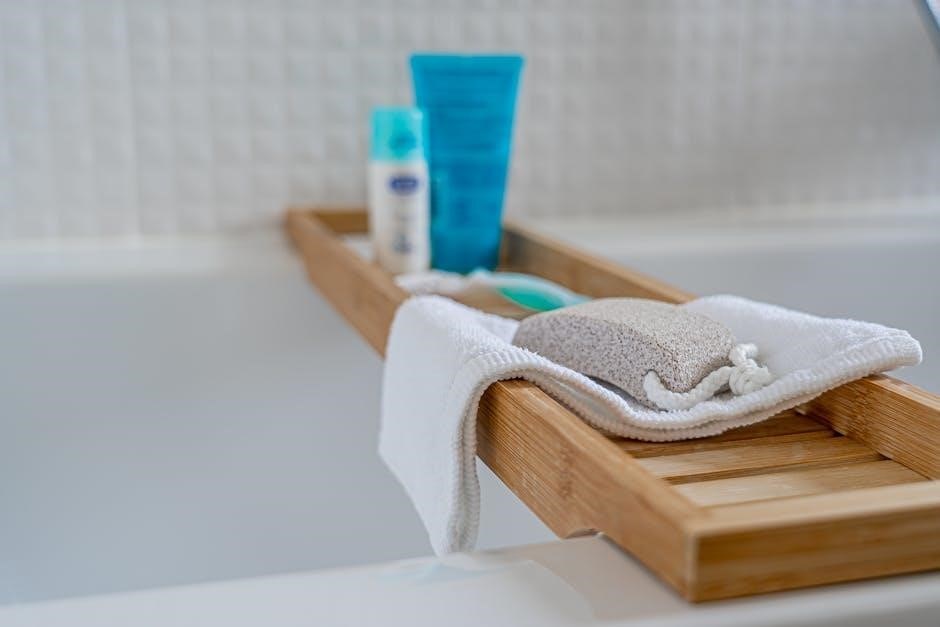What is a 30-Day Candida Cleanse?
Definition and Purpose of a Candida Cleanse
A Candida cleanse is a dietary and lifestyle protocol designed to reduce Candida overgrowth in the body. Candida is a type of yeast that naturally occurs in the human gut‚ mouth‚ and skin. When it multiplies excessively‚ it can lead to various health issues.
The primary purpose of a Candida cleanse is to restore balance to the gut microbiome by starving the yeast of its primary food source: sugar. This involves eliminating sugary foods‚ refined carbohydrates‚ and processed items from the diet.
The cleanse also aims to support the immune system and promote the growth of beneficial bacteria in the gut‚ which can help keep Candida levels in check. Probiotics and antifungal supplements are often incorporated into the cleanse to further aid in this process.
Ultimately‚ a Candida cleanse seeks to alleviate symptoms associated with Candida overgrowth‚ such as fatigue‚ digestive issues‚ skin problems‚ and recurrent infections. By addressing the underlying imbalance in the gut‚ the cleanse aims to promote overall health and well-being.
Candida Overgrowth: Causes and Symptoms
Candida overgrowth‚ also known as Candidiasis‚ occurs when the Candida fungus‚ naturally present in the body‚ multiplies uncontrollably. Several factors can contribute to this imbalance. A diet high in sugar and refined carbohydrates provides the primary fuel for Candida growth.
Antibiotic use can disrupt the balance of gut bacteria‚ killing off beneficial microorganisms that keep Candida in check. Chronic stress can also weaken the immune system‚ making it harder to control Candida levels. Certain medications‚ such as oral contraceptives and steroids‚ can also promote Candida overgrowth.
Symptoms of Candida overgrowth can vary widely. Common symptoms include fatigue‚ digestive issues like bloating and constipation‚ skin problems such as rashes and eczema‚ and recurrent yeast infections. Other symptoms may include brain fog‚ joint pain‚ and mood swings.
In severe cases‚ Candida overgrowth can lead to systemic infections‚ where the fungus spreads throughout the body. This can cause more serious health problems and require medical intervention. Recognizing the causes and symptoms of Candida overgrowth is crucial for effective treatment and prevention.

Key Components of a 30-Day Candida Cleanse
A Candida cleanse involves dietary changes‚ limiting sugar and processed foods. Supplementation with probiotics and antifungals is essential. Focusing on gut health is crucial for restoring balance. These components synergistically combat Candida overgrowth and promote overall wellness effectively.
Dietary Changes: Foods to Eat and Avoid
Dietary modifications form the cornerstone of a successful Candida cleanse; This involves strategically selecting foods that inhibit Candida growth while avoiding those that promote it. The primary goal is to starve the Candida yeast by drastically reducing sugar intake‚ as sugar fuels its proliferation and biofilm formation.
Acceptable foods include non-starchy vegetables‚ such as leafy greens‚ broccoli‚ and cauliflower‚ which provide essential nutrients without contributing to sugar overload. Some low-sugar fruits like berries are permissible in moderation. Gluten-free grains like quinoa and buckwheat can be included‚ along with lean proteins‚ healthy oils‚ and various herbs and spices to enhance flavor and nutritional value.
Conversely‚ foods to avoid encompass a wide range of items high in sugars‚ gluten‚ and inflammatory compounds. This includes refined sugars‚ processed foods‚ white bread‚ white pasta‚ and most cereals. Minimizing caffeinated drinks and incorporating anti-inflammatory foods like olive oil‚ leafy greens‚ nuts‚ seeds‚ and fatty fish is also crucial for supporting the body’s healing process during the cleanse.
Ultimately‚ these dietary shifts aim to restore gut health‚ reduce inflammation‚ and rebalance gut flora‚ creating an environment that is unfavorable to Candida overgrowth.
Foods to Include in Your Candida Cleanse Diet
Embarking on a Candida cleanse doesn’t mean depriving yourself of delicious and nutritious meals. Instead‚ it’s about making informed choices that support your body’s healing process. Prioritize foods that are low in sugar‚ gluten-free‚ and anti-inflammatory to create an environment where Candida struggles to thrive.
Non-starchy vegetables should form the bulk of your diet. Think leafy greens like spinach and kale‚ cruciferous vegetables like broccoli and cauliflower‚ and other options like zucchini and cucumbers. These provide essential vitamins‚ minerals‚ and fiber without spiking your blood sugar.
Incorporate small portions of low-sugar fruits such as berries (blueberries‚ raspberries‚ strawberries) for a touch of sweetness and antioxidants. Gluten-free grains like quinoa‚ buckwheat‚ and millet can provide complex carbohydrates and fiber‚ promoting satiety and digestive health. Lean proteins such as chicken‚ fish‚ and legumes are essential for muscle repair and overall well-being.
Healthy fats from sources like olive oil‚ avocado‚ nuts‚ and seeds contribute to satiety‚ hormone production‚ and nutrient absorption. Finally‚ don’t underestimate the power of herbs and spices. Many offer anti-inflammatory and antifungal properties‚ adding flavor and health benefits to your meals.
Foods to Avoid During a Candida Cleanse
Successfully completing a Candida cleanse requires diligent avoidance of specific food groups that can fuel Candida overgrowth or exacerbate inflammation. Understanding which foods to eliminate is crucial for creating an environment where Candida struggles to thrive. The primary categories to avoid are sugars‚ gluten‚ and highly processed items.
Sugars‚ in all their forms‚ are the primary fuel source for Candida. This includes refined sugar‚ honey‚ maple syrup‚ and even high-sugar fruits. Candida utilizes sugar to build protective biofilms‚ shielding itself from your immune system. Gluten‚ found in wheat‚ barley‚ and rye‚ can trigger inflammation in the gut‚ disrupting the balance of your microbiome.
Processed foods often contain hidden sugars‚ unhealthy fats‚ and artificial additives that can further promote inflammation and hinder your body’s healing process. Limit your intake of alcohol‚ as it converts to sugar in the body and can weaken your immune system. Certain dairy products‚ especially those high in lactose‚ may also need to be avoided due to their sugar content.
By carefully eliminating these food groups‚ you can starve Candida‚ reduce inflammation‚ and support your body’s natural ability to restore balance.
Supplementation: Probiotics and Antifungals
Supplementation plays a vital role in a successful 30-day Candida cleanse‚ working synergistically with dietary changes to combat Candida overgrowth and restore gut health. Two key categories of supplements are probiotics and antifungals. Probiotics introduce beneficial bacteria into the gut‚ helping to re-establish a healthy balance of microorganisms. These good bacteria compete with Candida for resources‚ limiting its growth and helping to crowd it out.
Choose a high-quality probiotic supplement with multiple strains of beneficial bacteria‚ such as Lactobacillus and Bifidobacterium‚ to maximize its effectiveness. Antifungal supplements‚ on the other hand‚ directly target and kill Candida cells. Natural antifungals like caprylic acid‚ oregano oil‚ and garlic have potent antifungal properties and can help to reduce Candida levels in the body.
It’s crucial to choose high-quality supplements from reputable brands to ensure their purity and potency. When introducing antifungal supplements‚ start with a low dose and gradually increase it to minimize potential die-off symptoms. Consulting with a healthcare professional is recommended before starting any new supplement regimen to determine the appropriate dosages and ensure they are safe for you.
The Role of Gut Health in Candida Control
Gut health is paramount in controlling Candida overgrowth. A healthy gut microbiome‚ teeming with beneficial bacteria‚ acts as a natural defense against Candida‚ keeping its population in check. These beneficial bacteria compete with Candida for nutrients and space‚ preventing it from multiplying excessively and causing problems. They also produce substances that inhibit Candida’s growth and help maintain a balanced gut environment.
Conversely‚ an imbalanced gut microbiome‚ often caused by factors like antibiotics‚ poor diet‚ and stress‚ can create an environment conducive to Candida overgrowth; When beneficial bacteria are depleted‚ Candida can thrive and colonize the gut‚ leading to various health issues. Therefore‚ restoring and maintaining gut health is crucial for long-term Candida control.
This can be achieved through dietary changes‚ such as consuming probiotic-rich foods and avoiding processed foods‚ as well as supplementation with probiotics and prebiotics. By nurturing a healthy gut microbiome‚ you can strengthen your body’s natural defenses against Candida and promote overall well-being.

Sample 30-Day Candida Cleanse Plan
Meal Plan Ideas and Recipes
Creating a successful 30-day Candida cleanse involves careful planning of meals and incorporating delicious recipes that support gut health. Focus on incorporating anti-inflammatory foods‚ non-starchy vegetables‚ and lean proteins. Breakfast ideas might include avocado baked eggs or a smoothie with berries‚ unsweetened almond milk‚ and protein powder.
For lunch‚ consider salads with leafy greens‚ grilled chicken or fish‚ and a variety of colorful vegetables. Dressings can be made using olive oil‚ lemon juice‚ and herbs. Dinner options could include baked salmon with roasted vegetables like broccoli‚ zucchini‚ and cauliflower.
When planning meals‚ remember to avoid sugar‚ gluten‚ and processed foods. Emphasize whole‚ unprocessed ingredients. Snacks can include raw nuts‚ seeds‚ or a small serving of berries. Experiment with different recipes to find meals that are both enjoyable and beneficial for your cleanse.
Also‚ remember to stay hydrated by drinking plenty of water throughout the day. Herbal teas‚ such as chamomile or ginger tea‚ can also be included to support digestion and reduce inflammation. By following a well-structured meal plan and exploring new recipes‚ you can make your 30-day Candida cleanse a positive and sustainable experience.

Important Considerations and Precautions
Before starting a 30-day Candida cleanse‚ it’s crucial to consult with a healthcare professional. Individual responses to the cleanse can vary‚ and potential side effects should be managed carefully. Prioritize your health and well-being by seeking expert guidance throughout the process.
Consulting a Healthcare Professional
Prior to initiating any significant dietary or supplemental changes‚ especially a 30-day Candida cleanse‚ seeking guidance from a qualified healthcare professional is paramount. This step ensures safety and personalized recommendations.
A doctor‚ registered dietitian‚ or certified nutritionist can assess your individual health status‚ medical history‚ and current medications to determine if a Candida cleanse is appropriate for you.
They can also help identify potential contraindications‚ such as underlying health conditions or interactions with existing treatments. Furthermore‚ a healthcare provider can monitor your progress during the cleanse.
They can address any concerns or side effects that may arise. Their expertise ensures that the cleanse is conducted safely and effectively‚ tailored to your specific needs and circumstances.
Remember‚ self-treating Candida overgrowth can sometimes mask other underlying health problems‚ so professional guidance is essential for accurate diagnosis and comprehensive care. A healthcare professional’s advice will ensure a balanced approach.
This approach prioritizes your overall well-being during the Candida cleanse journey. They offer the necessary support for achieving optimal results.
Potential Side Effects and How to Manage Them
Embarking on a 30-day Candida cleanse can trigger various side effects as the body adjusts to dietary changes and the die-off of Candida yeast. It’s crucial to be aware of these potential reactions and have strategies to manage them effectively.
One common side effect is the “Candida die-off‚” also known as the Herxheimer reaction. This occurs when dying Candida releases toxins into the bloodstream‚ leading to flu-like symptoms such as fatigue‚ headache‚ nausea‚ and body aches. To mitigate these symptoms‚ it’s essential to stay well-hydrated by drinking plenty of water throughout the day.
Consuming fiber-rich foods‚ like non-starchy vegetables‚ can help bind and eliminate toxins. Gentle exercise‚ such as walking‚ can also aid detoxification. Additionally‚ consider supporting your liver with supplements like milk thistle‚ which promotes liver function. It is also important to introduce dietary changes gradually‚ rather than abruptly‚ to minimize the severity of die-off symptoms.

If side effects become overwhelming‚ consult with a healthcare professional. They can provide personalized guidance and recommend appropriate interventions to alleviate discomfort. Remember‚ managing side effects is a crucial part of a successful Candida cleanse journey;

